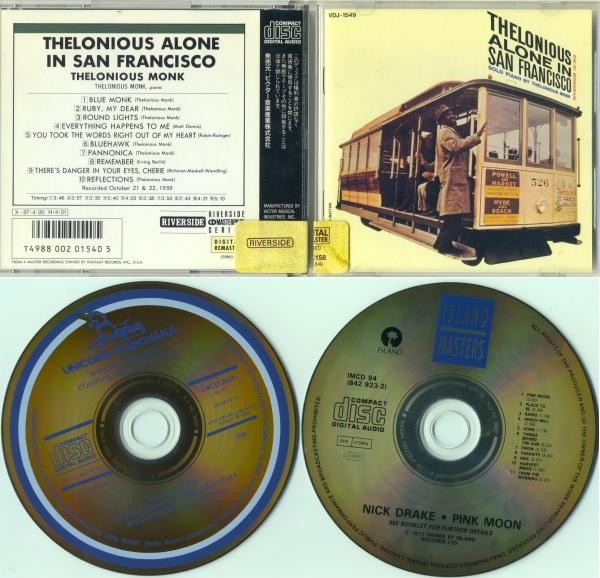I sold of almost all Optical Disc media,Laserdiscs back in the day and CD's also.. Or I would buy, listen, rip then sell back to Amoeba..
CD Rot, Rack, and Ruin

CD rot is a deterioration in the reflective layer of a CD, though rot can happen to any kind of optical disc. The laserdisc version was called laser rot. You need to know that a CD starts with polycarbonate plastic into which "pits" and "lands" representing zeroes and ones are molded. The pitted side of the disc is sprayed with a metallized layer which is then sealed by lacquer and labeled. The metallized layer is usually aluminum, which can oxidize, interfering with the reflectivity that the player's laser needs to read the pits and lands. When the rot goes far enough, it can overcome the disc player's error correction, leading to audible noise and glitches.
"Perfect sound forever," promised the inventors of the CD format. "Bollocks," answered defenders of the LP. But it was the "perfect sound" part they were questioning, not the "forever" part. Turns out that was a bill of goods too.
Excuse me if I sound bitter. But starting in 1985, a few years after the debut of the Compact Disc, I started investing substantial amounts of my inkstained-wretch pennies in the format. The rotting disc in question was a Japanese import for which I'd paid $18 (in mid-'80s dollars) at Tower Records—because if you wanted digital Monk and wanted it right away, those JVC releases were the first to become available. And I loved my copies of Brilliant Corners, Monk's Music, The Unique Thelonious Monk, and the San Francisco solo-piano disc mentioned above. I had assumed they would be my companions for life.
So the San Francisco disc no longer plays adequately in my Oppo universal disc player. However, the others still play in the Oppo just fine, and even the San Francisco disc plays in a Rotel RCD-965BX. Note that this vintage Red Book CD player may have the advantage because it is designed specifically to read CDs, as opposed to Blu-ray discs, DVDs, and SACDs, with CDs as an afterthought. The disc did not rip successfully in a Lenovo Windows 10 desktop PC. The Apple Lossless files were marred from the first track onward. To fill the gap in my library, I borrowed and ripped a later CD release from the public library.
Can you see CD rot as well as hear it? There are two telltale signs.
Can you see CD rot as well as hear it? There are two telltale signs. One is a series of pinholes that are visible in the metallized layer when you look through the disc into a bright light. All four of my Monk CDs have these pinholes. Monk's Music even has what appear to be scratches or gashes that are present in the metallized layer but not on the plastic playing surface itself (I handle discs carefully, avoiding scratches and finger marks). I'd spot-check a few other parts of my library, but right now, frankly, I just don't have the stomach for it.Another (but rarer) telltale sign is bronzing. Two bronzed specimens from my library are in the picture above: Nick Drake's Pink Moon and Bernard Herrmann's soundtrack music from Psycho. Bronzing is said to affect the label side first; in both of these cases it is extremely visible on the label side but, to the naked eye, not on the playing side, which still appears silvery. Drake still plays well in the Oppo, despite having a couple of alarmingly large pinholes; Herrmann starts playing badly midway through, despite having no pinholes. Go figure. Luckily I have both on vinyl and Drake in 24/96 FLAC as well. In the less redundant parts of my library, I may not be so lucky.
CD bronzing is largely blamed on PDO, a British manufacturing plant operated by Philips and Dupont in Blackburn, Lancashire. Inevitably I can't help thinking of John Lennon's line from "A Day in the Life" about "4000 holes in Blackburn, Lancashire." Holes that bedevil our lasers and break our hearts. Philips, as coinventor of the format, should have known better.
Finding CD rot in the aluminum layers of mass-manufactured discs has been an unwelcome surprise. I had been hoping I wouldn't see it in my lifetime (I'm 60 and my oldest discs go back three decades). Instead I had expected to see the few hundred CD-Rs I own, mostly burned from LPs or gifts from friends, rot first. Unlike regular CDs, whose pits and lands are stamped and metallized, CD-Rs use a less robust chemical process to represent the digits. But when I recently took out a few of the oldest CD-Rs to rip in lossless, they seemed fine.
As a guy who enjoys his music library, I routinely pull CDs off the shelf at random and until now I've had no trouble playing any of them. But CD rot is officially underway in my library and presumably will only get worse over time. Guess I've got a lot more ripping to do.
Audio Editor Mark Fleischmann is the author of Practical Home Theater: A Guide to Video and Audio Systems, available in both print and Kindle editions.
- Log in or register to post comments


You do know what you are doing is the equivalent of stealing music, right?

Hi,
Thanks for passing on the info. I've started ripping my library, so far all is fine, even those purchased in the early 80s. Also part of the inspiration to rip is my recent purchase of a Polk MagniFi Mini Soundbar, it's great for casual listening which I haven't done in years. I have a library of 450 or so disks most of which are for casual listening.
Cheers,




















































